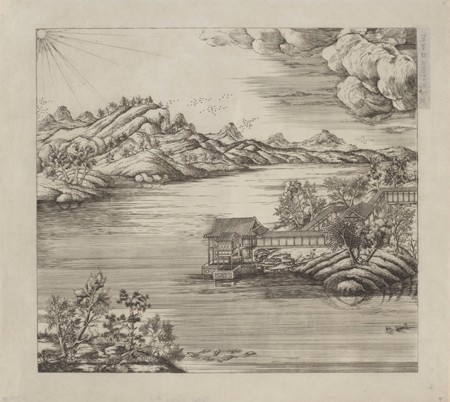The exact constitution of the group of artists is not known, but between 1712 and 1714 three markedly different versions of the album were produced. The first, by the master Wang Yuanqi 王原祁 (1642–1715), joined scenes in Wang’s Orthodox School manner with the emperor’s own verses, a combination of text and image often seen in albums recording literati gardens of southern China. The second, a woodblock-printed book, in some sense recreated Wang’s painted album using designs by a lesser-known court painter, Shen Yu 沈喻 (1649–after 1712). Finally, the emperor instructed an Italian missionary at the court, Matteo Ripa (1682–1746), to train two Qing apprentices in copperplate intaglio printing, a process heretofore unknown in Asia, to create an engraved version of the woodblock prints “in the European style.”
Each version not only employed different media but was also intended for a different audience. The paintings were, of course, the emperor’s private possession, while the woodblock prints conveyed that personal object to a wider, albeit still quite limited, audience of imperial intimates. The engravings not only translated images of a Qing garden into a foreign technology; they also carried those images abroad, as many of the sets traveled to Europe through one form of
The series of albums of the Thirty-Six Views raises questions about the stakes of style, genre, and technology in the early Qing; the introduction of Western pictorial techniques into Qing court practice and the evolution of their use; and the way in which pictorial and literary art was strategically produced and deployed to address a varied host of domestic and global audiences. The combination of stylistic, generic, and technological inputs created works of art that mirrored the multiethnic, global dynasty in its diverse composition, landscapes that were uniquely and quintessentially Qing.
These issues of transcultural exchange, pictorial technologies, and conceptualizations of imperial identity are at the center of my current work, a monographic study of Qing imperial landscape, entitled “Constructing Kangxi: Landscape and Authority in the Early Qing.” The text first explores the Mountain Estate as a physical, pictorial, and conceptual landscape under the Kangxi emperor before turning to consider Kangxi’s legacy as conveyed through the site in both the eighteenth-century court and popular culture of the nineteenth and twentieth centuries.
One goal of the book is to counter a prevailing emphasis in Qing history and art history on the reign of Kangxi’s grandson, the Qianlong emperor (r. 1735–1795). By understanding how Kangxi’s conception for, and realization of, the Mountain Estate differed from those of his successors, particularly Qianlong, I hope to be able to use the imperial park as evidence in larger arguments about evolving ideologies and understandings of emperorship during the Qing. In the coming months, I will turn to new sources of evidence, particularly archival materials, as I gather data useful for mapping the Mountain Estate under the Kangxi emperor. Digital mapping and spatial analysis offer historians of gardens and landscapes powerful new tools for peeling back layers of change at a site in order to expose earlier strata of development.
These projects, in turn, have stimulated my interest in the movement of objects and images in the early modern world, as well as the role of art and exchange in international diplomacy of the era. To this end, I am working on an edited volume exploring the role of landscape in the articulation and exercise of state identity, ideology, and power across the early modern world. Stemming from a panel organized at the College Art Association 2014 annual meeting, “Early Modern Imperial Landscapes in Comparative Perspective,” the volume gathers contributions that address East and South Asia, the Islamic world, and Europe in order to understand ways in which changes in communication, mobility, technology, and the economy, all of which influenced the nature of state-society relations, were negotiated through landscapes produced by, or in response to, early modern courts.
Members' Research Report Archive
Picturing the Qing: Style, Genre, Technology, and the Multivocal Landscape
Stephen Hart Whiteman
A. W. Mellon Postdoctoral Fellow, 2012–2014
In the late summer of 1711, the Kangxi emperor (r. 1661–1722),

Attributed to Matteo Ripa, with others, Morning Mist along the Western Ridge (Xiling chenxia 西嶺晨霞), from the copperplate edition of Imperial Poems on the Mountain Estate to Escape the Heat (Yuzhi Bishu shanzhuang shi 御製避暑山莊詩), 1712 – 1714. Philadelphia Museum of Art, Purchased with the Joseph E. Temple Fund, 1961